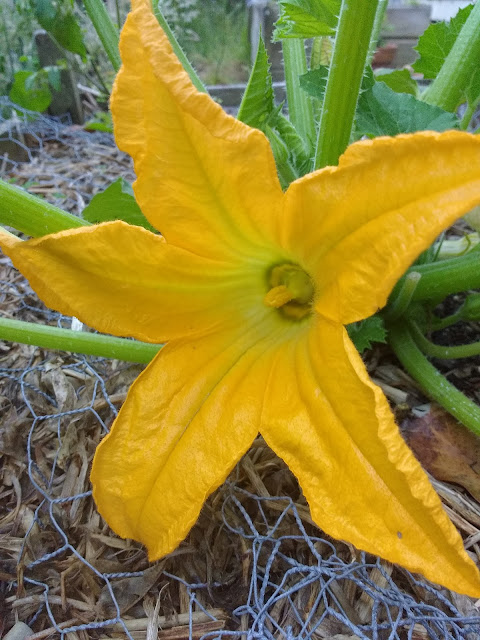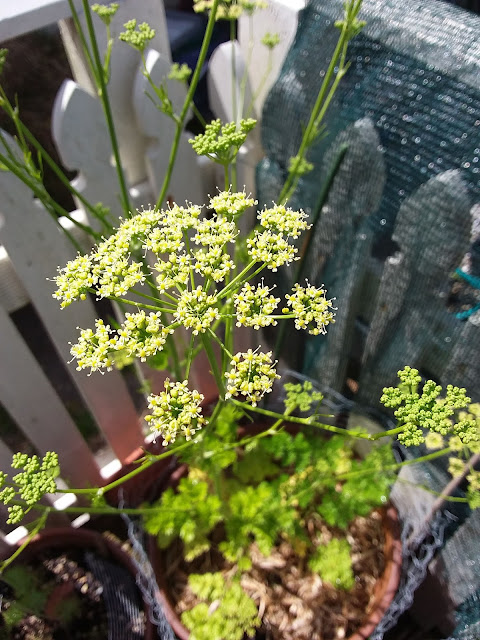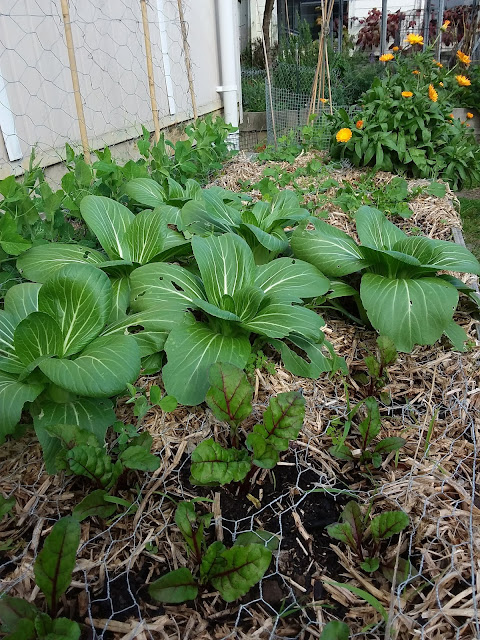There Are Also Flowers
When I became a veggie gardener I had no idea I was going to have so much to do with flowers. I was in it for the magical process of turning seeds and soil and thin air into food. I was surprised by the beauty I found in the food plants I grew. Not the least of this is the flowers of the things we grow for their fruits. The delicate bells on blueberries, the bold scarlet on the runner beans. Even the big sunny yellow flowers of the courgette:
Nothing says veggie garden like a few sunflowers waving their sunny heads above your tomatoes and summer squash. I have grown the big tall classic sunflower for years, but last year I bought a packet of a smaller ornamental variety - as seen above - and I was charmed by their beauty. Of course the larger varieties can also be grown for their edible seeds. But their tall central stem always leads to a bit of drama in our windy weather - I usualy end up having to stake them up. These shorter beauties have no such troubles, and they grow multiple flowers into the bargain. An added bonus of all varieties is that they turn into natural bird feeders as the seeds mature. I always leave at least one for the birds to enjoy.
I love thier bright colours and funny circular leaves. They are very easy to grow. Give them good soil and they are equally happy in sun or shade. They tend to sprawl, and if left to their own devices they will drop seeds over half your garden. This is not a problem, though, as they are very easy to pull out or cut back if they are getting in the way. In theory the entire plant is edible but I don't care for the taste of the leaf or stem. The flowers are more mild, and look very good on top of a salad. I have heard the still-green seeds can be pickled like capers but I haven't tried it. The one pictured is the classic eye catching red-orange, but they come in a variety of colours. I bought colour-mixed seed packet one year, and the subsequent generations have been surprising me with their various shades ever since.
Another example of an herb that has beneficial flowers. If you are growing thyme for culinary purposes as well, you'll need to be mindful with your pruning so that it gets a chance to flower. This one is a lemon thyme, which is beautiful in salads and egg dishes. Yes you can eat the flowers too, though the flavour is a little strong.
But today I want to talk about the other flowers I work with on a regular basis: the beneficials. A beneficial is a plant that is grown near your veggies in order to help them out. If you're trying to grow organically, it's an important piece of the puzzle. There are many roles a benefical could play, but the ones we grow for their flowers are there to entice the good bugs to come hang out in the veggie garden. They are a good place to start with beneficals, because they tend to benefit a large range of plants, and their placement doesn't need to be exact.
While they serve their practical purpose, there is a really wide range of beneficials to choose from, so I get to have fun picking the ones I most like to look at. The more variety the better your garden is protected, so I try to expand my range each year. On the practical side, though, I don't have a lot of time for pampering these plants, so I favour the low maintenance options. The things that have done well in my garden with very little fuss. Mostly prolific self-seeders or hearty perennials. Many of these do double duty, having other uses or being themselves herbs I would want to grow anyway.
There are the bee attractors. Some veggies need to be insect pollenated, so you will do well to give the bees plenty of reason to hang around. There are a lot of pollenators, but mostly we are talking about honey bees and bumble bees. You have a really wide range of options here, as bees will go for most medium to large flowers with an open structure (think single layer of petals with easy access to the middle). Though the cheeky bumble bee, when faced with a tubular flower, is capable of simply poking a hole near the base of it to extract nectar.
Here are a few things I grow for bees:
Sunflowers
Lavender
There are many varieties of lavender to choose from. The ones available where I live fall into three main categories: Spanish, English, or French. At this point I have a few of each. I just love the smell of lavender, and their elegant beauty. I would grow them for that alone. If you want lavender for the flowers - for harvesting and drying - go for the English varieties, which have the best smell. French lavender - pictured above - is the largest and most hearty in our climate. It is often grown as a hedge around here. Spanish lavender is perhaps the most showy, with long frilly petals at the end of each flower spike. They come in quite a few colour varieties. The good news is the bees are not fussy - the love all of them.
Rosemary
Rosemary is one of the many herbs in the garden that doubles as a beneficial. It is one of my favourite garden herbs. Give it a sunny, well drained spot, and it will require very little of you. And it just happens to be one of my favourites to use in the kitchen. Mine has no flowers right now, and that is my fault. I picked the wrong variety for this garden bed. It grows big and tall and needs very serious pruning to keep from crowding out its neighbours. I really should have gone for a prostrate variety. The point is I left it very late pruning this year and now it's too busy with new growth to start in on flowers.
Nasturtium
Calendula
These sunny flowers have a long blooming season in our climate if kept well pruned. They also keep going for a few years, making then technically perennials, though they are often grown as annuals. They are easy going either way as they are prolificly self-seeding. Calendula flower petals are edible, and look great as a finishing touch on cakes. They are said to have healing properties, making them a popular ingredient in healing creams and ointments. There are many varieties out there, both in shade and petal style. I got mine from seeds harvested at my local community garden. That was four years ago and as many generations of growing this friendly plant. I have so fallen in love with it that I won't bring in any other varieties for fear of cross pollenating and losing this strain. I love the pop of orange colour, and the way it gently fades to a paler shade at the centre.
Borage
Borage is a famous bee attractant. With its big prickly leaves and small flowers, it is not usually grown for its good looks. However, I find the tiny blue-purple flowers are rather beautiful up close. I grow it with caution; Given enough sun and nutrients it can produce a sprawl of foliage which rivals the courgettes, and crowds out your veggitables. After a few problems with this, I grow it only in the shade and not not too near my veggies. They self seed like crazy, so I simply weed out most of the new plants in Spring and leave a few to grow. They are tecnhically edible, and the blue flowers do look nice in a salad. The leaves are said to taste like cucumber, but I'm not fond of the prickly texture.
Comfrey
Comfrey is a plant much loved by veggie gardeners. The main reason to grow it is not the flowers at all. In fact it was a surprise to me when mine started flowering this year and I saw how polular they were with the bumble bees. Comfrey is a desciduous prennial. Its roots dig deep down into the soil and pull up nutriets that other plants can't reach. This makes their leaves particularly rich in nutrients, and great for putting in your compost. Most gardeners grown comfrey either for feeding the compost bin or making liquid fertiliser. They are also good for planting under fruit trees. I planted mine last year to try to help out an ailing avocado tree. As the leaves die back in the Fall, you let them fall where they are and compost into food for your fruit tree.
Then there are the plants that attract the good bugs that eat the bad bugs. There are a large range of these, the most reconisable being the ladybug. There are many others, such as hover flys and parasitic wasps, but they are small and easy to miss unless you are looking for them. What they have in common is that they eat aphids and other pest insects that eat your plants. The other thing they have in common is that they are small, with little mouth parts, and they like very little flowers. There are not a huge number of ornamentals with tiny flowers, but there are a variety of herbs that fit the bill.
Some things I grow for these insect predators:
Alyssum
These little plants spread out but stay fairly low to the ground, making them great to plant under your taller perennials or to pop into gaps in the veggie garden. They make masses of tiny flowers that smell of honey. The most common type is your basic white, but if you want to have bit of fun with it, they come in many shades of purple. They are easy to find in the local garden centre, as they are also grown as ornamentals.
Forget-me-not
These sweet, old fashioned little flowers were growing as volunteers all over my garden when we moved into our current house. The flowers are on the border between small and medium sized, and so attract bees as well. Put a few around your garden and leave then to drop their seeds and you will never need to plant more. They come in blues and whites. These blue ones with the tiny yellow centres are my favourite.
Thyme
Parsley / dill / fennel / corriander / celery
All of these herbs are in the Parsley Family and they all make very similar-looking white to pale yellow flowers. The flowers themselves are miniscule but they grow in rather attractive sprays on the ends of tall stems. If you want to grow these herbs for their beneficial flowers, you will have to be patient. From a culinary perspective, you want a long growing season before they go to seed. Once they have started to bolt, you simply pick one or two that won't inconvenience you too much and let it keep on growing. If you're really patient, you can then let them develop seeds to store for growing next season. Or harvest the seeds to use in the kitchen - especially fennel, dill, and corriander. Even one healthy plant will make hundreds of seeds, enough to make good use of in the kitchen.
It is worth noting that there is a fair ammount of cross over between flowers bees like and flowers that other beneficial insects like. A beneficial plant is rarely beneficial in just one way. The beautify of nearly all the plants I grow as beneficials, is that they have multiple uses in my garden. And while I tend to focus on the practical side when selecting garden plants, I also want to celebrate the beauty they bring to my garden and my life. The splashes of colour, the scent of rosemary or lavendar as I brush past them, all add to the joy I feel in the garden every day.














Comments
Post a Comment